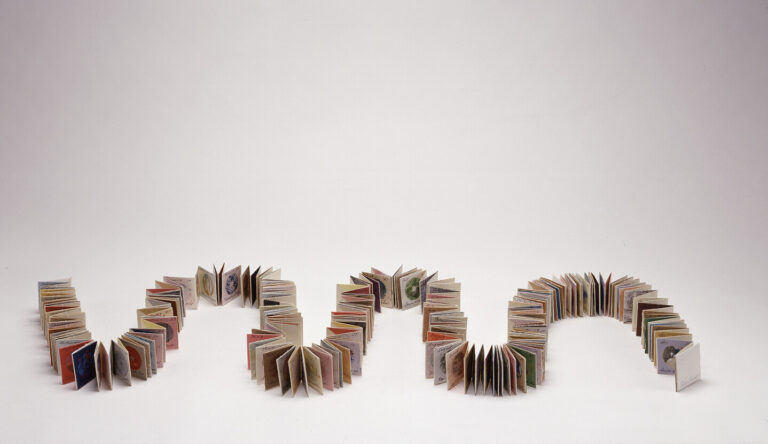Accordion books zig, zag, open, and close, recalling their namesake musical instruments. Originating from an effort during the Tang dynasty (618–908 CE) in China to make unwieldy scrolls more manageable, this basic format is easy to adapt, embellish, and incorporate into other artist book types.

Pat Oleszko, Glove Story, 1996; Lithograph, scanned photographs, linen, cotton gloves, 15 1/2 x 15 1/2 in.; National Museum of Women in the Arts, Museum purchase: United States Department of Education Fund; © Pat Oleszko
In On This Land, images by Karen Kunc (b. 1952) suggest landscape, open farms, and contrasting sky, while a poem by Lenora Castillo (b. 1950) tells of dislocation from Mexico to Nebraska, the strangeness of a new place, and the gradual acceptance of austere beauty. Hand-printed woodcuts and letterpress-printed text form a tactile and colorful interpretation of earth and human presence.
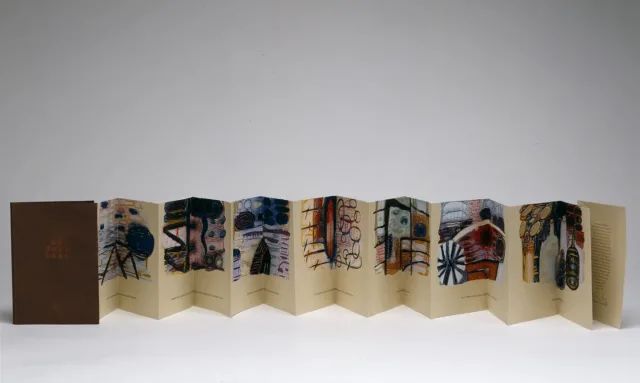
Karen S. Kunc, On This Land, 1996; Woodcut on paper and walnut stain on flax paper, 5 1/4 x 7 1/2 in.; National Museum of Women in the Arts, Purchased with funds provided by the Library Fellows of the National Museum of Women in the Arts; © Karen Kunc
Interested in dreams since childhood, Genie Shenk (1937–2018) created Dreamlog as part of a series of daily documentations compiled since 1982. The artist inscribed the titles by hand, and the circles and squares create a repeating mandala pattern. She feels that the spontaneous marks come from the same deep source as the dreams themselves. The two-inch-square pages extend to 61 feet long!

Genie Shenk, Dreamlog, 1995-1996; Japanese mulberry paper, found paper, acrylic, gouache, ink, 2 x 2 x 12 in.; National Museum of Women in the Arts, Gift of the artist; © 1995-1996 Genie Shenk
Near the end of her mother’s life, Donatella Franchi (b. 1942) used books to help re-create their relationship. Inspired by the images of her mother’s hands on pages and Portrait of a Noblewoman with a Young Girl by Lavinia Fontana (1552–1614), which depicts a mother passing a red-bound volume to her daughter, A Clotilde celebrates a lifelong reader.

Donatella Franchi, A Clotilde, 2009; Museum board, photographs, ink, 8 x 8 1/2 in.; National Museum of Women in the Arts, Gift of Lynn M. Johnston; Photo by Lee Stalsworth
In The Reptilian Brain, Leah Michelle Geiger (b. 1971) explores what distinguishes the human brain from its avian and reptilian counterparts. Though remnants of the primitive brain activate in periods of high stress (fight or flight), she supposes a third option where the need to flee or charge may bend to reason and make way for peaceful coexistence.
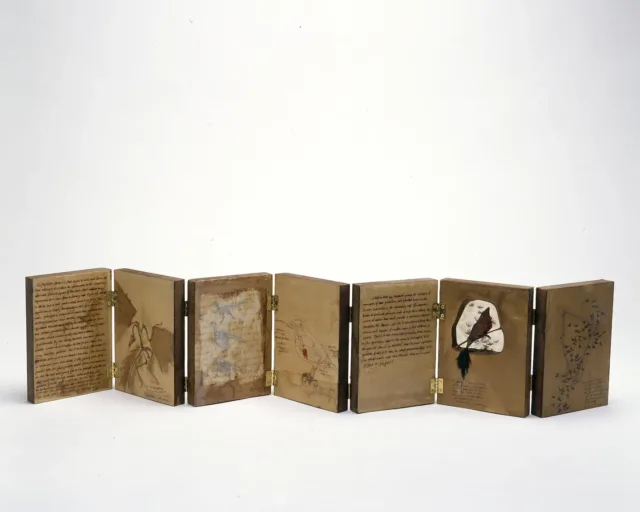
Leah Michelle Geiger, The Reptilian Brain, 2003; Encaustic panels, paper, feathers, quail egg, brass hinges, 3 1/2 x 6 in.; National Museum of Women in the Arts, Gift of the artist
Art History Lessons is about the experiences of artist Laura Davidson (b. 1957) during a year of treatment for breast cancer. Using slides of frescoes by Giotto di Bondone bookended by vintage postcards depicting sculptures of women, the pages—representing melancholy, anger, hope, and peace—reflect her shift from a place of fragility to one of strength and confidence.
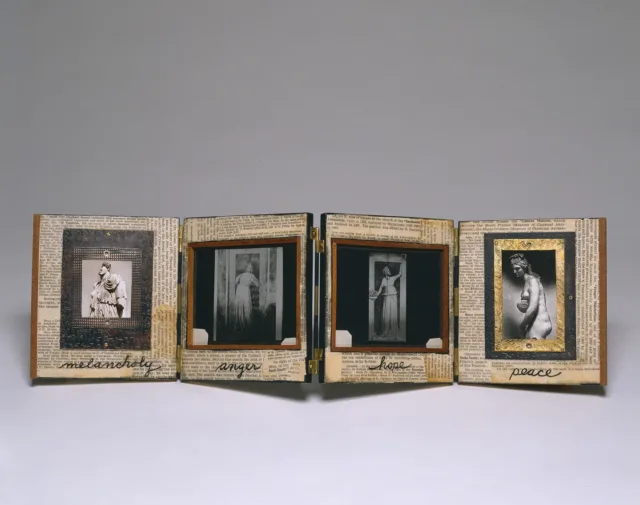
Laura Davidson, Art History Lessons, 2005; Wood, metal, lantern slides, postcards, travel guide pages, 5 x 18 in.; National Museum of Women in the Arts
For What’s Happening with Momma?, Clarissa Sligh (b. 1939) used her family album and a child’s perspective to critique the construction of family photos. Negatives were pieced together and printed to create a small, safe, ephemeral space. Opening the door reveals accordion steps adhered to the interior, which houses a fearful story based on a memory of her younger sister’s home birth.
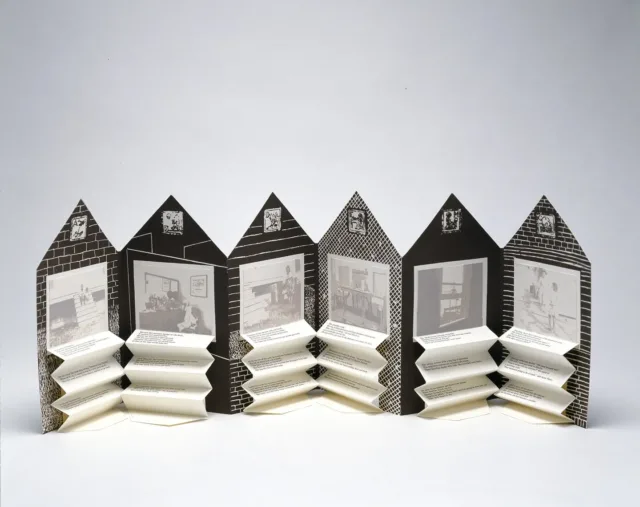
Clarissa Sligh, What’s Happening with Momma?, 1988; Silkscreen and letterpress on paper, 6 1/2 x 11 1/2 in.; National Museum of Women in the Arts, Gift of Clayre Baessler Liammari; © Clarissa Sligh
Lois Morrison (b. 1934) imitated a 1934 storybook to create something beautiful that reveals a dark surprise upon closer examination. In Endangered Species, pop-up flowers disclose tragedies of children in the favelas of Brazil, child soldiers in ravaged Uganda, victims of infanticide in China, and victims of violence and drug addiction in the United States.

Lois Morrison, Endangered Species, 1999; Cloth over board, color-copied drawings, Gocco prints, paper, color pen, 7 x 9 in.; National Museum of Women in the Arts, Gift of Lois Pollard Price; © Lois Morrison
Circulus Sapientiae by Claire Van Vliet (b. 1933) is a celebration of the 900th birthday of Hildegard von Bingen (1098–1179), a medieval abbess who was a composer and poet. Latin texts of 12 songs from von Bingen’s Symphony of the Harmony of Celestial Revelations anchor the seven-spread accordion. A CD of ten hymns performed by Anima, a Vermont-based ensemble, is included.
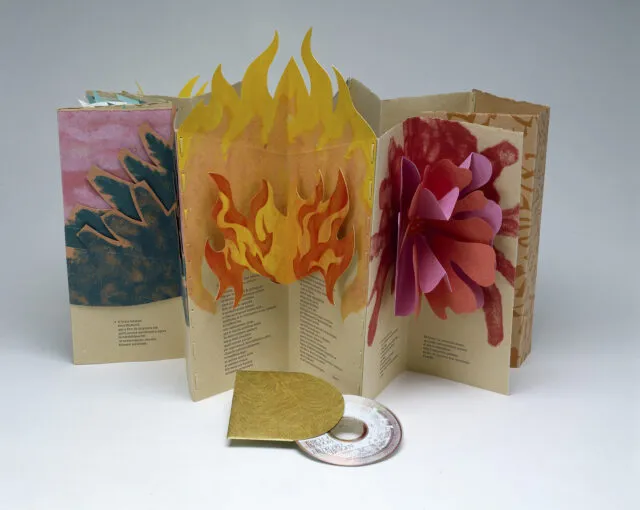
Claire Van Vliet, Circulus Sapientiae (Circle of Wisdom), 2001; Pulp painting on handmade paper, CD, 5 1/2 x 12 in.; National Museum of Women in the Arts, Museum purchase: Library and Research Center Acquisition Fund; © Claire Van Vliet
When Kazuko Watanabe (b. 1949) translated her grandfather’s journals, called The Diary of a Sparrow, she discovered the history of a people living within a small stretch of land, their lives tossed by war and the encroachment of the modern world. Wishing to convey the rich and thoughtful journey to a wider audience, she designed this book to unfold like a small Japanese house.

Kazuko Watanabe, The Diary of a Sparrow, 1999; Multiple-plate color etchings, computer-manipulated photoetched images, handprinted on European and Japanese paper, 9 1/4 x 7 1/2 in.; National Museum of Women in the Arts, Purchased with funds provided by the Library Fellows of the National Museum of Women in the Arts; © 1999 Kazuko Watanabe
Glove Story is a play, a ploy, a costume drama, and a pun-ridden metaphorical plow through contemporary personal relations. Pat Oleszko (b. 1947) introduces Ms. Glove Lee, a gossip columnist responding to letters that arrive from characteristically adorned gloves. In the course of her generosity, Glove Lee advises a certain Lone Lee. They meet, and it is, of course, glove at first sight.
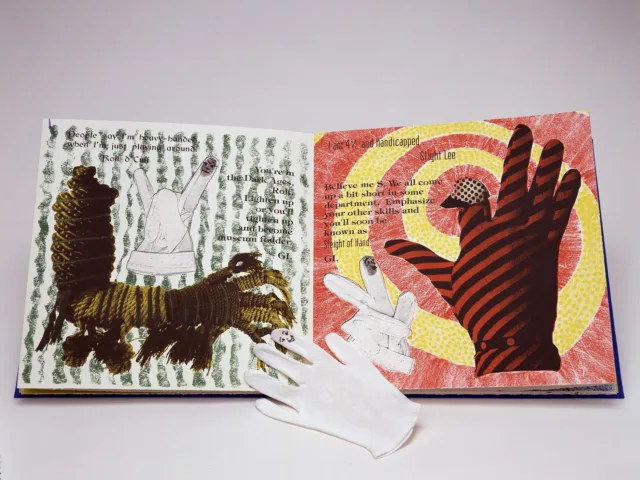
Pat Oleszko, Glove Story, 1996; Lithograph, scanned photographs, linen, cotton gloves, 15 1/2 x 15 1/2 in.; National Museum of Women in the Arts, Museum purchase: United States Department of Education Fund; © Pat Oleszko
This online exhibition series is created with gratitude to Curator Emerita Krystyna Wasserman, who assembled the museum’s rich collection of artists’ books during her 30-year career.
Text is adapted from object labels from the special exhibition The Book as Art: Artists’ Books from the National Museum of Women in the Arts (October 27, 2006–February 4, 2007).
Inspired to teach someone how to create an artist’s book or to make one yourself? Check out NMWA’s Art, Books, and Creativity Curriculum.
Online exhibition team: Traci Christensen, Deborah L. Gaston, Adrienne L. Gayoso, Alicia Gregory, Ashley W. Harris, Mara Kurlandsky, Elizabeth Lynch, Adrienne Poon, and Emily Shaw.
Photos by Lee Stalsworth unless otherwise noted.

Genie Shenk, Dreamlog, 1995-1996; Japanese mulberry paper, found paper, acrylic, gouache, ink, 2 x 2 x 12 in.; National Museum of Women in the Arts, Gift of the artist; © 1995-1996 Genie Shenk

